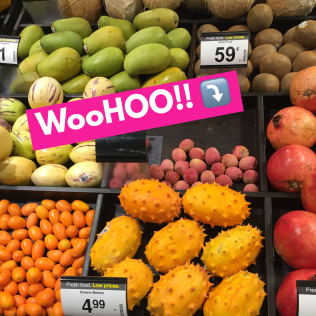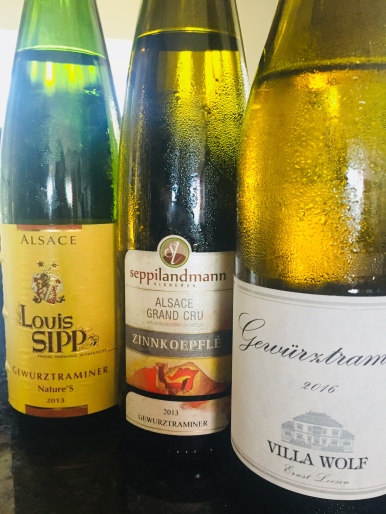There are some wines that are said to be identifiable in a blind tasting based definitively on a single aromatic “tell”. The theory is, if you smell X – the wine cannot be anything other than Y. So, for example, if you get a distinct petrol aroma from a wine – you’re very likely drinking German Riesling. (BTW – “petrol” is the Brits fancy name for gasoline). Similarly, if you smell wet wool you’re almost certainly sipping Vouvray (Chenin Blanc from the Loire Valley). And if you’re getting lychee fruit on the nose – it’s said to be Gewürztraminer.
Now, I know what petrol and wet wool smell like – but lychee? I’d never even heard of this fruit previously, let alone seen, smelled or tasted it. And since you rarely run across a tasting note for Gewürztraminer without seeing “lychee” as a primary descriptor, I set out to find it and give it a taste test of my own. (Note: I do not plan on doing the same when I post on Sauvignon Blanc, where one of the most common descriptors is cat pee.)
Apparently finding lychees is easier said than done. After searching for a few weeks at several grocery stores and smaller boutique markets in my area, I remained lycheeless. One produce guy told me that they sometimes got lychee in stock, but not frequently. Another said they didn’t have lychee but they did have white peaches. I asked him if those smelled or tasted like lychee and his response was “no, not really.” Mmmmkaaaaaaaaaaay – I’ll pass.
I’d finally given up all lychee hope and figured I’d just have to drink Gewürztraminer and remain in the dark about the mysterious fruit. But then, what should appear before my very eyes . . .

During one of my thrice weekly trips to the grocery store I spied it! Hidden among the other “freak fruits” like Kiwano and Pepino Melons was a small selection of lychees. I excitedly (seriously) scooped up some and raced home to taste them.
After first having to google how the hell to open the fruit, Hubs and I cracked the shell and dug into the lychee. And, perhaps not surprisingly, it tasted like Gewürztraminer. It was incredibly tart and sweet at the same time with a bold tropical and floral flavor. It was intensely flavorful – almost obnoxiously so. Which is basically how I feel about Gewürztraminer.
Enough about Lychees – Let’s Talk about Grapes. Gewürztraminer is grown all over the world – from Northeastern Italy, to my beloved Washington state, to New Zealand. The name, not surprisingly, has German roots (“Gewürz” means spice in German), but in fact represents only a very small percentage of plantings in Germany (my research shows in the neighborhood of 1-5%). The most significant plantings of Gewürztraminer are in the Alsace region of France with approximately 8,000 acres planted to the grape. And in Alsace, they drop the umlaut (and you, dear reader, can drop that little wine factoid at your next tasting to impress your friends and neighbors!).
Along with lychee, other aromas and flavors found in Gewürz are typically roses, honey, grapefruit, gingerbread and an assortment of exotic spices. Gewürztraminer can be made in a variety of styles – from dry to sweet. The latter are often labelled either “Vendanges Tardives” or “Selections de Grains Nobles” – both of which are late harvested grapes after the sugars have had additional time to concentrate on the vine.
Prior to my lychee hunt, I’d purchased a few bottles of Gewürztraminer and had Hubs blind pour me a tasting of the three. Here are my condensed tasting notes – sans lychee descriptors because I hadn’t been able to find it yet! 
Villa Wolf 2016 Gewürztraminer, Pfalz, Germany. (11.5% abv)
This wine was by far the lightest colored, lightest bodied and zippiest of the three. It was the least like a “classic” Gewürztraminer should taste like – and it was my favorite. 🙂 Refreshing with lots of pink grapefruit, crisp minerality and citrus. In general, the Pfalz region of Germany is known for producing lighter styled Gewürztraminer than Alsace. Which is something I’ll keep in mind for the future . . .
Louis SIPP 2013 Nature’S Gewurztraminer, Alsace, France. (13% abv)
This Gewürz had a lot going on with rich aromas of honeysuckle, melon, salinity and spices. I also thought I was getting smoke on the nose here – but this probably because Hubs was messing around outside with his new smoker and the windows were open (hmmm…I’m getting a very strong sense of hickory!!). Each time I smelled or sipped I’d find something else in the glass. The wine was fuller bodied than the first with much lower acidity. Based on the producer’s website the “Nature’S” wording on the label means that the wine was made from organically farmed grapes and certified by ECOCERT (one of the largest organic certification organizations in the world). Overall, a very interesting wine.
Seppi Landmann 2013 Gewurztraminer Zinnkoepflé Grand Cru, Alsace, France. (13% abv)
This last wine was the ripest and richest of the three with big ol’ aromas of perfume, sandalwood, tropical fruits and crushed pine needles (which I thought was odd, but I was definitely smelling this!). As a Grand Cru, this wine is theoretically at the top of the quality pyramid as these vineyard sites are recognized for their extraordinary terroirs. There are 51 Grand Cru sites in Alsace, yet only around 4% of all Alsace wine produced is Grand Cru. This Gewurz would undoubtedly be considered the “best” of the three – case in point: Wine Enthusiast gave it a 93.
However, it was personally my least favorite. I could appreciate its complexity and ageability – at 5 years and going strong with intense aromas and flavors (note: most Gewürz are meant to drink within a few years). But it just was not my style. I prefer something a bit more crisp and restrained – which Gewürztraminer just isn’t ever going to be.
For more information about this grape – visit my outline on Gewurztraminer.

